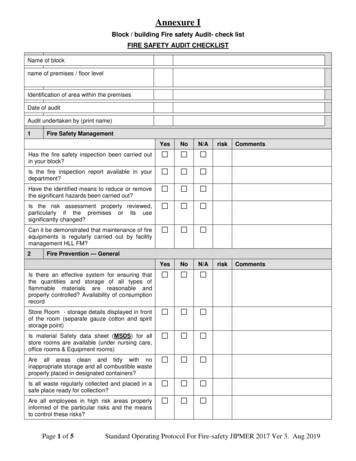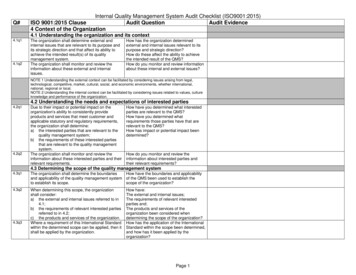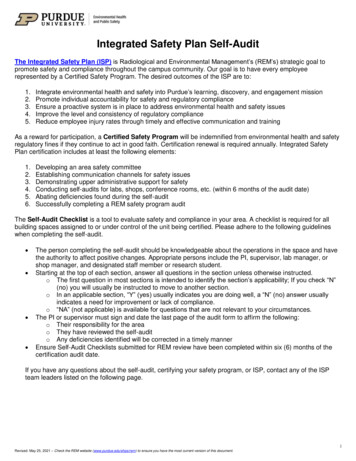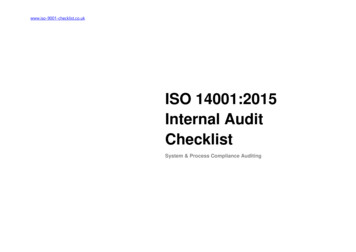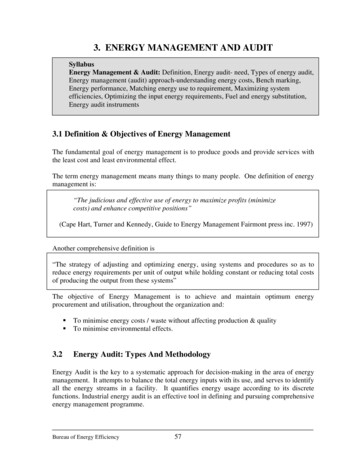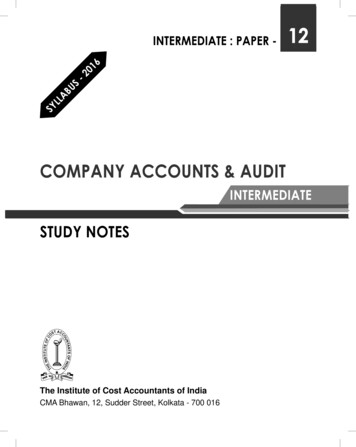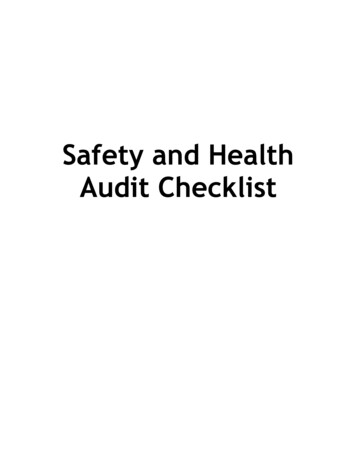
Transcription
Safety and HealthAudit Checklist
Table of ContentsPOSTING. 1MEDICAL SERVICES AND FIRST AID . 2FIRE PROTECTION. 3PERSONAL PROTECTIVE EQUIPMENT AND CLOTHING. 5GENERAL WORK ENVIRONMENT . 7WALKWAYS . 8FLOOR AND WALL OPENINGS . 9STAIRS AND STAIRWAYS . 10ELEVATED SURFACES. 12EXITING OR EGRESS. 13EXIT DOORS. 15PORTABLE LADDERS. 16HAND TOOLS AND EQUIPMENT . 18PORTABLE (POWER OPERATED) TOOLS AND EQUIPMENT. 20ABRASIVE WHEEL EQUIPMENT - GRINDERS . 21POWDER-ACTUATED TOOLS. 22MACHINE GUARDING. 23LOCKOUT/TAGOUT PROCEDURES . 25WELDING, CUTTING, AND BRAZING . 27COMPRESSORS AND COMPRESSED AIR . 30COMPRESSED AIR RECEIVERS. 32COMPRESSED GAS CYLINDERS . 33HOIST AND AUXILIARY EQUIPMENT . 34INDUSTRIAL TRUCKS/FORKLIFTS. 35ENTERING CONFINED SPACES . 36FLAMMABLE AND COMBUSTIBLE MATERIALS. 38HAZARDOUS CHEMICAL EXPOSURE. 40HAZARDOUS SUBSTANCES COMMUNICATION . 42ELECTRICAL . 43NOISE. 46FUELING. 47IDENTIFICATION OF PIPING SYSTEMS . 48MATERIAL HANDLING. 49TRANSPORTING EMPLOYEES AND MATERIALS . 50TIRE INFLATION. 51TRACTOR AND FARM MACHINERY . 52i
Safety and Health Audit Checklist: Directions Do the best you can to answer the questions in each section. If you don't understand the question or don't know the answer, just put a question mark orother mark next to the question. If a whole section does not apply (e.g., you don’t have that type of equipment) just mark itout with a slash. Contact Environmental Health and Safety (EH&S) (nph4@cornell.edu; 255-8200) or CALSOccupational and Environmental Health (OEH) (eh22@cornell.edu; 255-0485) if you reallyget stuck.ii
Safety and Health Audit Checklist: Facility InformationFacility name:Date:Who takes the lead on safety issues at this facility?What work-related injuries or illnesses have been reported at this facility during the last 3-5years?If you have any safety concerns that are not addressed by any of the questions in the checklists,please write them in below:iii
Safety and Health Audit Checklist—CALS Remote Facilitiesp. 1 of 1PostingDIRECTIONS:Do the best you can to answer the questions in each section.If you don't understand the question or don't know the answer, just put a question mark or other mark next to thequestion. If a whole section does not apply (e.g., you don’t have that type of equipment) just mark it out with a slash. Contact Environmental Health and Safety (EH&S) (nph4@cornell.edu; 255-8200) or CALS Occupational andEnvironmental Health (OEH) (eh22@cornell.edu; 255-0485) if you really get stuck. N/AOKNotOK1. Is the required OSHA workplace poster displayed in a prominentlocation where all employees are likely to see it? 2. Are emergency telephone numbers posted where they can be readilyfound in case of emergency? 3. Where employees may be exposed to any toxic substances or harmfulphysical agents, has appropriate information concerning employeeaccess to medical and exposure records, and Material Safety DataSheets, etc. been posted or otherwise made readily available to affectedemployees? 4. Are signs concerning exiting from buildings, room capacities, floorloading, exposures to x-ray, microwave or other harmful radiation orexposures to other harmful substances posted where appropriate? Comments:CALS OEH: 9/2006File Location: http://oeh.cals.cornell.eduThis information is intended only for Cornell University, and may contain legally confidential and/or privileged material. Anyforwarding, copying, disclosure, distribution, or other use of this information by any person is prohibited without the permission ofthe University.1
Safety and Health Audit Checklist—CALS Remote Facilitiesp. 1 of 1Medical Services and First AidDIRECTIONS:Do the best you can to answer the questions in each section.If you don't understand the question or don't know the answer, just put a question mark or other mark next to thequestion. If a whole section does not apply (e.g., you don’t have that type of equipment) just mark it out with a slash. Contact Environmental Health and Safety (EH&S) (nph4@cornell.edu; 255-8200) or CALS Occupational andEnvironmental Health (OEH) (eh22@cornell.edu; 255-0485) if you really get stuck. N/AOKNotOK1. Is there a hospital, clinic, or infirmary for medical care in proximity ofyour workplace? 2. If medical and first aid facilities are not in proximity of your workplace,is at least one employee on each shift currently qualified to render firstaid? 3. Are medical personnel readily available for advice and consultation onmatters of employees' health? 4. Are first aid kits easily accessible to each work area, with necessarysupplies available, periodically inspected and replenished as needed? 5. Have first aid kit supplies been approved by a physician, indicating thatthey are adequate for a particular area or operation? 6. Are means provided for quick drenching or flushing of the eyes andbody in areas where corrosive liquids or materials (including lead-acidbatteries) are handled? Comments:CALS OEH: 9/2006File Location: http://oeh.cals.cornell.eduThis information is intended only for Cornell University, and may contain legally confidential and/or privileged material. Anyforwarding, copying, disclosure, distribution, or other use of this information by any person is prohibited without the permission ofthe University.2
Safety and Health Audit Checklist—CALS Remote Facilitiesp. 1 of 2Fire ProtectionDIRECTIONS:Do the best you can to answer the questions in each section.If you don't understand the question or don't know the answer, just put a question mark or other mark next to thequestion. If a whole section does not apply (e.g., you don’t have that type of equipment) just mark it out with a slash. Contact Environmental Health and Safety (EH&S) (nph4@cornell.edu; 255-8200) or CALS Occupational andEnvironmental Health (OEH) (eh22@cornell.edu; 255-0485) if you really get stuck. N/AOKNotOK1. Is your local fire department well-acquainted with your facility, itslocation, and specific hazards? 2. If you have a fire alarm system, is it certified as required? 10. Is the maintenance of automatic sprinkler systems assigned toresponsible persons or to a sprinkler contractor? 11. Are sprinkler heads protected by metal guards, when possibly exposedto physical damage? 12. Is proper clearance maintained below sprinkler heads? 3. If you have a fire alarm system, is it tested at least annually?4. If you have interior stand pipes and valves, are they inspected regularly?5. If you have outside private fire hydrants, are they flushed at least once ayear and on a routine preventive maintenance schedule?6. Are fire doors and shutters in good operating condition?7. Are fire doors and shutters unobstructed and protected againstobstructions, including their counterweights?8. Are fire door and shutter fusible links in place?9. Are automatic sprinkler system water control valves, air and waterpressure checked weekly/periodically as required?13. Are portable fire extinguishers provided in adequate number and type?14. Are fire extinguishers mounted in readily accessible locations?15. Are fire extinguishers recharged regularly and noted on the inspectiontag?This information is intended only for Cornell University, and may contain legally confidential and/or privileged material. Anyforwarding, copying, disclosure, distribution, or other use of this information by any person is prohibited without the permission ofthe University.3
Safety and Health Audit Checklist—CALS Remote Facilitiesp. 2 of 2Fire Protection continued16. Are employees periodically instructed in the use of extinguishers andfire protection procedures?N/AOKNotOK Comments:CALS OEH: 9/2006File Location: http://oeh.cals.cornell.eduThis information is intended only for Cornell University, and may contain legally confidential and/or privileged material. Anyforwarding, copying, disclosure, distribution, or other use of this information by any person is prohibited without the permission ofthe University.4
Safety and Health Audit Checklist—CALS Remote Facilitiesp. 1 of 2Personal Protective Equipment and ClothingDIRECTIONS:Do the best you can to answer the questions in each section.If you don't understand the question or don't know the answer, just put a question mark or other mark next to thequestion. If a whole section does not apply (e.g., you don’t have that type of equipment) just mark it out with a slash. Contact Environmental Health and Safety (EH&S) (nph4@cornell.edu; 255-8200) or CALS Occupational andEnvironmental Health (OEH) (eh22@cornell.edu; 255-0485) if you really get stuck. N/AOKNotOK1. Are protective goggles or face shields provided and worn, where there isany danger of flying particles or corrosive materials? 2. Are approved safety glasses required to be worn at all times in areas wherethere is a risk of eye injuries such as punctures, abrasions, contusions, orbumps? 3. Are employees who need glasses in working environments having harmfulexposures required to wear only approved safety glasses, protectivegoggles, or use other medically approved precautionary procedures? 4. Are protective gloves, aprons, shields, or other means provided againstcuts, corrosive liquids, and chemicals? 5. Are hard hats provided and worn where danger of falling objects exists? 7. Is appropriate foot protection required where there is the risk of footinjuries from hot, corrosive, or poisonous substances, falling objects,crushing or penetrating actions? 8. Are approved respirators provided for regular or emergency use whereneeded? 9. Is all protective equipment maintained in a sanitary condition and ready foruse? 10. Do you have eyewash facilities and a quick drench shower within the workarea where employees are exposed to injurious corrosive materials? 11. Where special equipment is needed for electrical workers, is it available? 6. Are hard hats inspected periodically for damage to the shell andsuspension system?12. Where lunches are eaten on the premises, are they eaten in areas wherethere is no exposure to toxic materials or other health hazards?This information is intended only for Cornell University, and may contain legally confidential and/or privileged material. Anyforwarding, copying, disclosure, distribution, or other use of this information by any person is prohibited without the permission ofthe University.5
Safety and Health Audit Checklist—CALS Remote Facilitiesp. 2 of 2Personal Protective Equipment and Clothing continuedN/AOKNotOK13. Is protection against the effects of occupational noise exposure providedwhen sound levels exceed those of the OSHA noise standard? 14. Are adequate work procedures, protective clothing and equipmentprovided and used when cleaning up spilled toxic or otherwisehazardous materials or liquids? Comments:CALS OEH: 9/2006File Location: http://oeh.cals.cornell.eduThis information is intended only for Cornell University, and may contain legally confidential and/or privileged material. Anyforwarding, copying, disclosure, distribution, or other use of this information by any person is prohibited without the permission ofthe University.6
Safety and Health Audit Checklist—CALS Remote Facilitiesp. 1 of 1General Work EnvironmentDIRECTIONS:Do the best you can to answer the questions in each section.If you don't understand the question or don't know the answer, just put a question mark or other mark next to thequestion. If a whole section does not apply (e.g., you don’t have that type of equipment) just mark it out with a slash. Contact Environmental Health and Safety (EH&S) (nph4@cornell.edu; 255-8200) or CALS Occupational andEnvironmental Health (OEH) (eh22@cornell.edu; 255-0485) if you really get stuck. N/AOKNotOK 5. Are accumulations of combustible dust routinely removed from elevatedsurfaces including the overhead structure or buildings, etc.? 6. Is combustible dust cleaned up with a vacuum system to prevent thedust going into suspension? 7. Is metallic or conductive dust prevented from entering or accumulatingon or around electrical enclosures or equipment? 8. Are covered metal waste cans used for oily and paint-soaked waste? 1. Are all worksites clean and orderly?2. Are work surfaces kept dry or appropriate means taken to assure thesurfaces are slip-resistant?3. Are all spilled materials or liquids cleaned up immediately?4. Is combustible scrap, debris, and waste stored safely and removed fromthe worksite promptly?9. Are all oil and gas fired devices equipped with flame failure controlsthat will prevent flow of fuels if pilots or main burners are not working?10. Are the minimum number of toilets and washing facilities provided?11. Are all toilets and washing facilities clean and sanitary?12. Are all work areas adequately illuminated?13. Are pits and floor openings covered or otherwise guarded?Comments:CALS OEH: 9/2006File Location: http://oeh.cals.cornell.eduThis information is intended only for Cornell University, and may contain legally confidential and/or privileged material. Anyforwarding, copying, disclosure, distribution, or other use of this information by any person is prohibited without the permission ofthe University.7
Safety and Health Audit Checklist—CALS Remote Facilitiesp. 1 of 1WalkwaysDIRECTIONS:Do the best you can to answer the questions in each section.If you don't understand the question or don't know the answer, just put a question mark or other mark next to thequestion. If a whole section does not apply (e.g., you don’t have that type of equipment) just mark it out with a slash. Contact Environmental Health and Safety (EH&S) (nph4@cornell.edu; 255-8200) or CALS Occupational andEnvironmental Health (OEH) (eh22@cornell.edu; 255-0485) if you really get stuck. N/AOKNotOK 5. Is there safe clearance for walking in aisles where motorized ormechanical handling equipment is operating? 6. Are materials or equipment stored in such a way that sharp projectileswill not interfere with the walkway? 7. Are spilled materials cleaned up immediately? 10. Is adequate headroom provided for the entire length of any aisle orwalkway? 11. Are standard guardrails provided wherever aisle or walkway surfacesare elevated more than 30 inches above any adjacent floor or theground? 1. Are aisles and passageways kept clear?2. Are aisles and walkways marked as appropriate?3. Are wet surfaces covered with non-slip materials?4. Are holes in the floor, sidewalk, or other walking surface repairedproperly, covered, or otherwise made safe?8. Are changes of direction or elevations readily identifiable?9. Are aisles or walkways that pass near moving or operating machinery,welding operations, or similar operations arranged so that employeeswill not be subjected to potential hazards?Comments:CALS OEH: 9/2006File Location: http://oeh.cals.cornell.eduThis information is intended only for Cornell University, and may contain legally confidential and/or privileged material. Anyforwarding, copying, disclosure, distribution, or other use of this information by any person is prohibited without the permission ofthe University.8
Safety and Health Audit Checklist—CALS Remote Facilitiesp. 1 of 1Floor and Wall OpeningsDIRECTIONS:Do the best you can to answer the questions in each section.If you don't understand the question or don't know the answer, just put a question mark or other mark next to thequestion. If a whole section does not apply (e.g., you don’t have that type of equipment) just mark it out with a slash. Contact Environmental Health and Safety (EH&S) (nph4@cornell.edu; 255-8200) or CALS Occupational andEnvironmental Health (OEH) (eh22@cornell.edu; 255-0485) if you really get stuck. N/AOKNotOK1. Are floor openings guarded by a cover, guardrail, or equivalent on allsides (except at entrance to stairways or ladders)? 2. Are all elevated surfaces (beneath which people or machinery could beexposed to falling objects) provided with standard 4-inch toeboards? 3. Are skylight screens of such construction and mounting that they willwithstand a load of at least 200 pounds? 4. Is the glass in the windows, doors, glass walls, etc., which are subject tohuman impact, of sufficient thickness and type for the condition of use? 5. Are grates or similar type covers over floor openings such as floordrains, of such design that foot traffic or rolling equipment will not beaffected by the grate spacing? 6. Are unused portions of service pits and pits not actually in use eithercovered or protected by guardrails or equivalent? 7. Are manhole covers, trench covers and similar covers, plus theirsupports designed to carry a truck rear axle load of at least 20,000 lbswhen located in roadways and subject to vehicle traffic? 8. Are floor or wall openings in fire resistive construction provided withdoors or covers compatible with the fire rating of the structure andprovided with a self-closing feature when appropriate? Comments:CALS OEH: 9/2006File Location: http://oeh.cals.cornell.eduThis information is intended only for Cornell University, and may contain legally confidential and/or privileged material. Anyforwarding, copying, disclosure, distribution, or other use of this information by any person is prohibited without the permission ofthe University.9
Safety and Health Audit Checklist—CALS Remote Facilitiesp. 1 of 2Stairs and StairwaysDIRECTIONS:Do the best you can to answer the questions in each section.If you don't understand the question or don't know the answer, just put a question mark or other mark next to thequestion. If a whole section does not apply (e.g., you don’t have that type of equipment) just mark it out with a slash. Contact Environmental Health and Safety (EH&S) (nph4@cornell.edu; 255-8200) or CALS Occupational andEnvironmental Health (OEH) (eh22@cornell.edu; 255-0485) if you really get stuck. N/AOKNotOK1. Are standard stair rails or handrails on all stairways having four or morerisers? 2. Are all stairways at least 22 inches wide? 6. Are step risers on stairs uniform from top to bottom, with no riserspacing greater than 7.5 inches? 7. Are steps on stairs and stairways designed or provided with a surfacethat renders them slip resistant? 8. Are stairway handrails located between 30 and 34 inches above theleading edge of stair treads? 9. Do stairway handrails have at least 3 inches of clearance between thehandrails and the wall or surface they are mounted on? 10. Are stairway handrails capable of withstanding a load of 200 pounds,applied in any direction? 11. Where stair or stairways exit directly into any area where vehicles maybe operated, are adequate barriers and warnings provided to preventemployees stepping into the path of traffic? 12. Do stairway landings have a dimension, measured in the direction oftravel, at least equal to the width of the stairway? 13. Is the vertical distance between stairway landings limited to 12 feet orless? 3. Do stairs have at least a 6 ft 6 in overhead clearance?4. Do stairs angle no more than 50 and no less than 30 degrees?5. Are stairs of hollow-pan type treads and landings filled to noising levelwith solid material?This information is intended only for Cornell University, and may contain legally confidential and/or privileged material. Anyforwarding, copying, disclosure, distribution, or other use of this information by any person is prohibited without the permission ofthe University.10
Safety and Health Audit Checklist—CALS Remote Facilitiesp. 2 of 2Stairs and Stairways ContinuedComments:CALS OEH: 9/2006File Location: http://oeh.cals.cornell.eduThis information is intended only for Cornell University, and may contain legally confidential and/or privileged material. Anyforwarding, copying, disclosure, distribution, or other use of this information by any person is prohibited without the permission ofthe University.11
Safety and Health Audit Checklist—CALS Remote Facilitiesp. 1 of 1Elevated SurfacesDIRECTIONS:Do the best you can to answer the questions in each section.If you don't understand the question or don't know the answer, just put a question mark or other mark next to thequestion. If a whole section does not apply (e.g., you don’t have that type of equipment) just mark it out with a slash. Contact Environmental Health and Safety (EH&S) (nph4@cornell.edu; 255-8200) or CALS Occupational andEnvironmental Health (OEH) (eh22@cornell.edu; 255-0485) if you really get stuck. N/AOKNotOK1. Are signs posted, when appropriate, showing the elevated surface loadcapacity? 2. Are surfaces elevated more than 30 inches above the floor or groundprovided with standard guardrails? 3. Is a permanent means of access and egress provided to elevated storageand work surfaces? 4. Is required headroom provided when necessary? 5. Is material on elevated surfaces piled, stacked, or racked in a manner toprevent it from tipping, falling, collapsing, rolling, or spreading?6. Are dock boards or bridge plates used when transferring materialsbetween docks and trucks?Comments:CALS OEH: 9/2006File Location: http://oeh.cals.cornell.eduThis information is intended only for Cornell University, and may contain legally confidential and/or privileged material. Anyforwarding, copying, disclosure, distribution, or other use of this information by any person is prohibited without the permission ofthe University.12
Safety and Health Audit Checklist—CALS Remote Facilitiesp. 1 of 2Exiting or EgressDIRECTIONS:Do the best you can to answer the questions in each section.If you don't understand the question or don't know the answer, just put a question mark or other mark next to thequestion. If a whole section does not apply (e.g., you don’t have that type of equipment) just mark it out with a slash. Contact Environmental Health and Safety (EH&S) (nph4@cornell.edu; 255-8200) or CALS Occupational andEnvironmental Health (OEH) (eh22@cornell.edu; 255-0485) if you really get stuck. N/AOKNotOK1. Are all exits marked with an exit sign and illuminated by a reliable lightsource? 2. Are the directions to exits, when not immediately apparent, marked withvisible signs? 3. Are doors, passageways, or stairways, that are neither exits nor access toexits and which could be mistaken for exits, appropriately marked"NOTAN EXIT", "TO BASEMENT", "STOREROOM", etc.? 4. Are exit signs provided with the word "EXIT" in lettering at least 5inches high and the stroke of the lettering at least 1/2-inch wide? 5. Are exit doors side-hinged? 10. Is the number of exits from each floor of a building and the number ofexits from the building itself, appropriate for the building occupancyload? 11. Where ramps are used as part of required exiting from a building, is theramp slope limited to 1-ft vertical and 12-ft horizontal? 12. Where exiting will be through frameless glass doors, glass exit doors,storm doors, etc., are the doors fully tempered and do they meet thesafety requirements for human impact? 6. Are all exits kept free of obstructions?7. Are at least two means of egress provided from elevated platforms, pits,or rooms where the absence of a second exit would increase the risk ofinjury from hot, poisonous, corrosive, suffocating, flammable, orexplosive substances?8. Are there sufficient exits to permit prompt escape in case of emergency?9. Are special precautions taken to protect employees during constructionand repair operations?This information is intended only for Cornell University, and may contain legally confidential and/or privileged material. Anyforwarding, copying, disclosure, distribution, or other use of this information by any person is prohibited without the permission ofthe University.13
Safety and Health Audit Checklist—CALS Remote Facilitiesp. 2 of 2Exiting or Egress continuedComments:CALS OEH: 9/2006File Location: http://oeh.cals.cornell.eduThis information is intended only for Cornell University, and may contain legally confidential and/or privileged material. Anyforwarding, copying, disclosure, distribution, or other use of this information by any person is prohibited without the permission ofthe University.14
Safety and Health Audit Checklist—CALS Remote Facilitiesp. 1 of 1Exit DoorsDIRECTIONS:Do the best you can to answer the questions in each section.If you don't understand the question or don't know the answer, just put a question mark or other mark next to thequestion. If a whole section does not apply (e.g., you don’t have that type of equipment) just mark it out with a slash. Contact Environmental Health and Safety (EH&S) (nph4@cornell.edu; 255-8200) or CALS Occupational andEnvironmental Health (OEH) (eh22@cornell.edu; 255-0485) if you really get stuck. N/AOKNotOK1. Are doors that are required to serve as exits designed and constructed sothat the way of exit travel is obvious and direct? 2. Are windows that could be mistaken for exit doors made inaccessible bymeans of barriers or railings? 3. Are exit doors operable from the direction of exit travel without the useof a key or any special knowledge or effort when the building isoccupied? 4. Is a revolving, sliding or overhead door prohibited from serving as arequired exit door? 5. Where panic hardware is installed on a required exit door, will it allowthe door to
Safety and Health Audit Checklist: Directions ii Do the best you can to answer the questions in each section. If you don't understand the question or don't know the answer, just put a question mark or other mark next to the question. If a whole section does not apply (e.g., you don't have that type of equipment) just mark it out with a slash.




